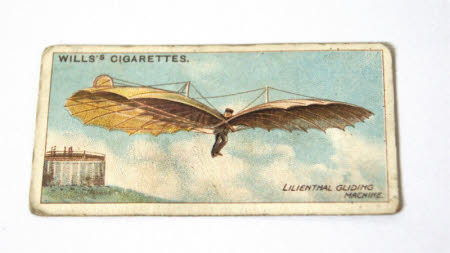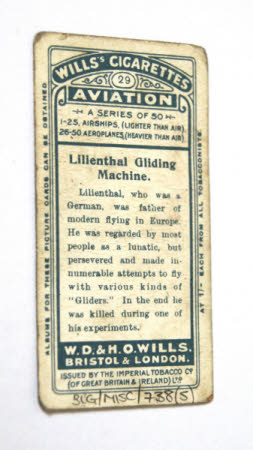Cigarette card
Wills's Cigarettes
Category
Ephemera
Date
Unknown
Materials
Card
Measurements
35 mm (Width); 67 mm (Length)
Order this imageCollection
Mr Straw's House, Nottinghamshire
NT 742586.6
Summary
One of a set of mismatched cigarette cards wrapped in a piece of newspaper. Cigarette card, the front has a full colour picture of a man between two wood and material wings to form an early glider. In the top left corner is printed 'WILLS's CIGARETTES.' and in the bottom right 'LILIENTHAL GLIDING MACHINE.'. On the back printed in blue ink on a white background; 'WILLS's CIGARETTES 29 AVIATION A SERIES OF 50 1-25 AIRSHIPS (LIGHTER THAN AIR). 26-50 AEROPLANES (HEAVIER THAN AIR). Lilienthal Gliding Machine. Lilienthal, who was a German, was father of modern flying in Europe. He was regarded by most people as a lunatic, but persevered and made in- numerable attempts to fly with various kinds of "Gliders." In the end he was killed during one of his experiments. W.D.&H.O.WILLS. BRISTOL&LONDON. ISSUED BY THE IMPERIAL TOBACCO Co. (OF GREAT BRITAIN&IRELAND)LTD.'. Printed vertically up each side; ALBUMS FOR THESE PICTURES CARDS CAN BE OBTAINED' 'AT 1\- EACH FROM ALL TOBACCONISTS'. Lilienthal was born on 23 May 1848 in Anklam, Pomerania Province, German kingdom of Prussia. According to his birth certificate, his parents were Carl Gustav, a merchant, and Caroline Wilhemina née Pohle. They belonged to the St. Nikolai evangelical church community in Anklam, where he later attended grammar school, and where he eventually studied the flight of birds with his brother Gustav (1849–1933). Fascinated by the idea of manned flight, Lilienthal and his brother made strap-on wings, but failed in their attempts to fly. He then attended the regional technical school in Potsdam for two years and trained at the Schwarzkopf Company before becoming a professional design engineer. He would later attend the Royal Technical Academy in Berlin. In 1867, Lilienthal began his experiments on the force of air in earnest, interrupted when he served in the Franco-Prussian War. As a staff engineer in various engineering companies, Lilienthal received his first patent for a mining machine. Five years later he founded his own company to make boilers and steam engines. Lilienthal published his famous book Birdflight as the Basis of Aviation in 1889. Lilienthal's greatest contribution was in the development of heavier-than-air flight. He made his flights from an artificial hill he built near Berlin and from natural hills, especially in the Rhinow region. The filing of a U.S. Patent in 1894 by Lilienthal directed pilots to grip the "bar" for carrying and flying the hang glider. The A-frame of Percy Pilcher and Lilienthal echoes in today's control frame for hang gliders and ultralight aircraft. Working in conjunction with his brother Gustav, Lilienthal made over 2,000 flights in gliders of his design starting in 1891 with his first glider version, the Derwitzer, until his death in a gliding crash in 1896. His total flying time was five hours. At the beginning, in 1891, Lilienthal succeeded with jumps and flights covering a distance of about 25 metres (82 ft). He could use the updraft of a 10 m/s wind against a hill to remain stationary with respect to the ground, shouting to a photographer on the ground to manoeuvre into the best position for a photo. In 1893, in the Rhinow Hills, he was able to achieve flight distances as long as 250 metres (820 ft). This record remained unbeaten for him or anyone else at the time of his death. Lilienthal did research in accurately describing the flight of birds, especially storks, and used polar diagrams for describing the aerodynamics of their wings. He made many experiments in an attempt to gather reliable aeronautical data.
Makers and roles
Wills's Cigarettes , manufacturer


